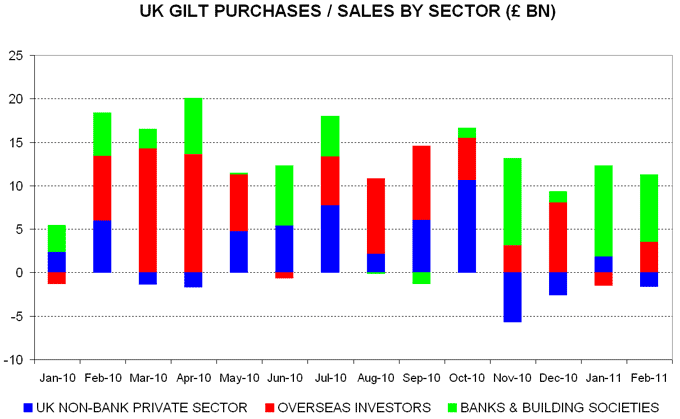UK banks absorbing bulk of gilt issuance
Gilt yields have been suppressed by strong demand from banks and building societies, which bought a further £7.7 billion in February following £10.5 billion in January, according to monetary statistics released today. Purchases totalled £29.6 billion between November and February, more than in the first 10 months of 2010 and equivalent to 84% of net gilt issuance – see chart.
Banks are buying gilts partly under regulatory pressure but also because private sector demand for bank loans remains weak. Any revival in credit demand would probably slow the rate of purchases and put upward pressure on gilt yields. For the moment, banks are effectively delivering the QE2 stimulus sought by MPC arch-dove Adam Posen.
Increased bank demand for gilts has offset a recent slowdown in overseas buying, which was boosted last year by capital flight from peripheral Eurozone economies. Foreign investors purchased £3.5 billion of gilts in February and £13.2 billion in the last four months, down from £67.6 billion between January and October 2010. The Portugese debt crisis should support overseas gilt demand near term.
Other features of today's monetary and revised GDP data include:
-
The Bank of England's favoured broad money measure, M4 excluding money holdings of "intermediate other financial corporations", fell by 0.5% in February, causing three-month growth to slump to 0.5% annualised from 3.2% in January. The February decline, however, was the result of money-holders switching into foreign currency deposits (not included in M4ex), possibly in anticipation of sterling weakness. Foreign currency deposits, excluding holdings of intermediate OFCs, rose by £11.8 billion in February, equivalent to 0.8% of M4ex.
-
Ignoring the foreign currency distortion, M4ex rose by 2.2% annualised in the six months to February, up from 1.6% in the prior six months. While growth remains sluggish, it is probably more than sufficient to finance trend economic expansion and 2% inflation given a rise in the velocity of circulation. Nominal domestic demand grew by 6.2% in the year to the fourth quarter despite M4ex expansion of only 1.8%. The Bank of England has recently acknowledged arguments for expecting velocity to continue to increase (see a box in the February Inflation Report and an article in the latest Quarterly Bulletin), implying that an acceptable M4ex growth rate may now be well below the minimum 5% previously suggested.
-
M4ex growth of 2.2% annualised in the six months to February compares favourably with Eurozone M3 expansion of 0.6% over the same period.
-
With the decline in GDP in the fourth quarter revised back to 0.5% from 0.6%, the Office for National Statistics now estimates that underlying output (i.e. excluding the impact of December's bad weather disruption) was "broadly flat" versus last month's assessment of a "slight fall". Based on labour market and survey data, further upgrades are likely. Note that GDP growth in the fourth quarter of 2009 has been revised up from an originally-reported 0.1% to 0.4%.


Reader Comments